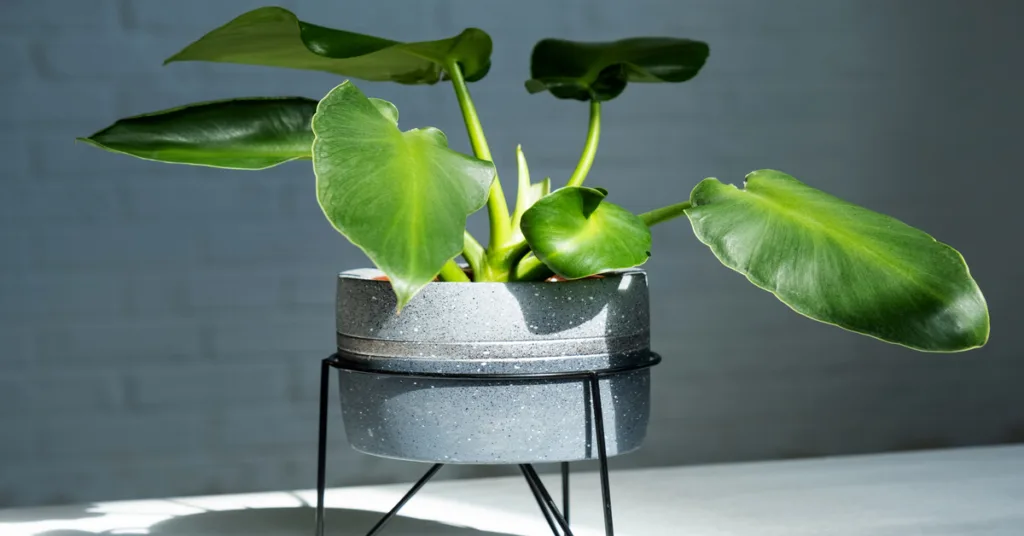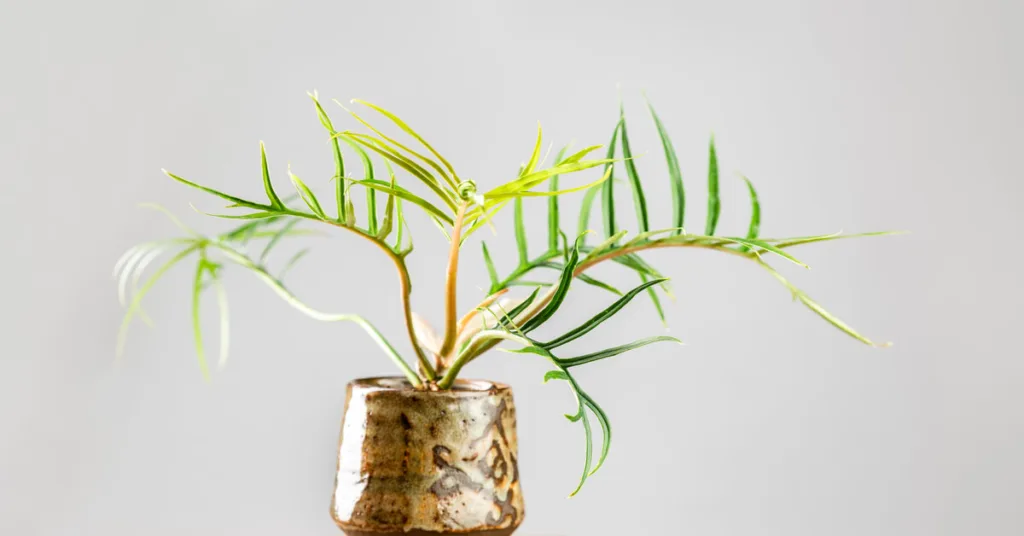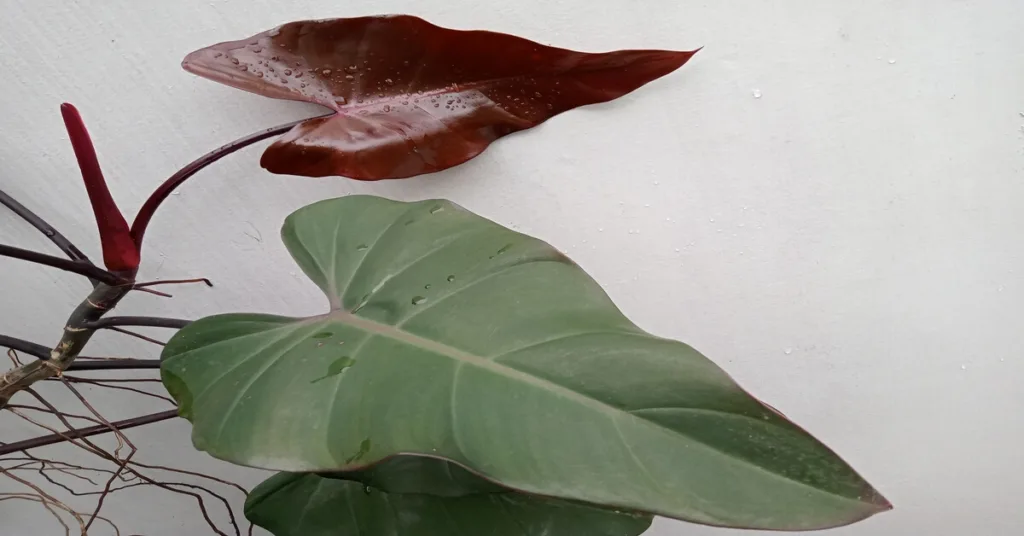Philodendron rugosum is a stunning and rare houseplant revered by plant collectors around the world. The leaves have a distinctive look that resembles a pig’s ear. That’s why it is commonly referred to as philodendron pig ear, pig ear plant, and pigskin philodendron.
The pig ear plant is endemic to the mountains of Ecuador and is nearing threatened status according to the ICUN[1]. That’s what makes this plant so rare which is why the price to purchase this plant is so high.
Since Philodendron rugosum is so rare, there’s been limited breeding efforts to create new cultivars of varieties. A Philodendron rugosum variegated form is available. It’s often referred to as Philodendron rugosum aberrant form.
Given the rarity and price of this houseplant, you’ll want to know how to properly care for it. Below we’ve outlined everything you need to know to make this plant thrive.
Philodendron rugosum Care

The care of Philodendron rugosum is similar to many other Philodendron plants. Two of the most important considerations regarding care are soil and water. This plant is susceptible to developing root rot but proper soil and watering can prevent root rot.
Philodendron rugosum yellow leaves can be caused by too much sun, low humidity, too much fertilizer, low magnesium, and disease. If you start noticing leaf discoloration you can use this guide to help you determine which of these factors is causing leaves to yellow.
Soil
Well-draining soil is a must when growing Philodendron rugosum. This will reduce the risk of plants developing root rot. You purchase a premade aroid mix or make your own with a few simple ingredients.
To make your own, simply mix equal parts of perlite, orchid bark, and peat moss. The orchid bark and perlite allow for good drainage, while the peat moss helps retain moisture.
Watering
Consistent soil moisture, without overwatering, is best for Philodendron rugosum. You should always check the soil to see if it needs water before adding any. Just stick your finger into the soil and only water if the top 2 or 3 inches feel dry.
Water the plant thoroughly when needed. Allow excess water to drain into a saucer and then dump the saucer. Never leave your pig ear philodendron sitting in a saucer of water to avoid causing root rot.
Root rot is another cause of yellow leaves on Philodendron rugosum.
Lighting
Philodendron rugosum grows best in bright indirect light. Direct sunlight can often burn the leaves and turn them yellow and brown.
On the other hand, low light levels won’t harm this plant but it will cause it to grow much slower. Low light levels may also cause Philodendron Pig Ear to produce smaller leaves.
Humidity & Temperature
Pigskin philodendron prefers temperatures between 55 and 90 degrees Fahrenheit. Most homes are kept well within this range. Just make sure not to place your plant too close to windows or doors where cold drafts in winter are likely to occur.
Humidity should be at least 40 percent to keep Philodendron rugosum happy. Lower humidity levels can cause leaves to begin yellowing over time. Since it’s a tropical plant, higher humidity levels are fine and can actually help this plant grow more vigorously.
Fertilizing
A monthly dose of diluted liquid fertilizer during spring and summer will improve the growth of pig ear plants. Any 1-1-1 (nitrogen-phosphorus-potassium) houseplant liquid fertilizer will do.
Avoid full-strength liquid fertilizers which can cause root damage. You also shouldn’t fertilize this plant during the winter dormant period.
Magnesium deficiency isn’t a common problem but can cause v-shaped yellow areas to form on leaves[2]. The v-shaped discoloration is distinctive so you’ll easily be able to tell if low magnesium is causing yellow leaves. To correct the issue, water the plant with a mixture of one gallon of water with one teaspoon of Epsom salt (magnesium sulfate)[2].
Propagation
Like most Philodendrons, there are several ways to propagate your Philodendron rugosum. There are three methods you can use: division, stem cuttings, and air layering.
Stem cuttings work best for the propagation of Philodendrons. Take a cutting from the end of one of your pig ear philodendron vines. Make sure you leave 3 to 4 leaves at the end of the cutting.
Cut ¼ of an inch past the last leaf you’re leaving on the mother plant. Then you can simply bury the cut end of the stem you removed into the soil 2 to 4 inches deep. You’ll want to keep the soil moist for several weeks to allow the roots to form.
Diseases & Pests
There are a couple of diseases and pests that can impact Philodendrons including pig ear plants.
Bacterial leaf spot causes irregularly shaped spots on the leaves[2]. The spots will be a reddish-brown color surrounded by a yellow halo. Avoid getting leaves wet when watering to prevent this disease.
Bacterial Blight will cause leaves to develop dark green spots that quickly grow larger and spread[2]. The leaves will ultimately begin to rot and release an unpleasant smell. You can prevent bacterial blight by keeping the leaves and stems dry at all times.
Both spider mites and mealybugs can infest Philodendron rugosum. The most common way they get on plants in your home is when you bring in a new plant that’s infested. If you notice either pest on your plant, insecticidal soap or neem oil will help get rid of them.
Toxicity
All Philodendrons contain insoluble calcium oxalates in their plant tissues. It is toxic to humans, cats, and dogs[3].
Ingesting insoluble calcium oxalates causes symptoms like mouth pain, drooling, and vomiting[3]. It can also cause swelling in the mouth and airways.
Types of Philodendron rugosum
Since Philodendron rugosum is a rare plant, it hasn’t been highly cultivated like other popular houseplants. There is only one different type of this species that you’ll find called ‘radiance’.
Philodendron rugosum ‘radiance’ is an aberrant form, not a cultivar, of Philodendron rugosum. It is also often just called Philodendron rugosum ‘aberrant’ or ‘aberrant form’.
It has variegated leaves that are also wavier. The leaves have a bright green stripe that runs along the midrib.
References:
[1] IUCN 2023. Philodendron rugosum. The IUCN Red List of Threatened Species. Version 2022-2.
[2] Moorman, G.W. (2016). Philodendron Diseases. PennState Extension.
[3] Plants Toxic To Animals. (2022, May 11). Illinois University Library.



